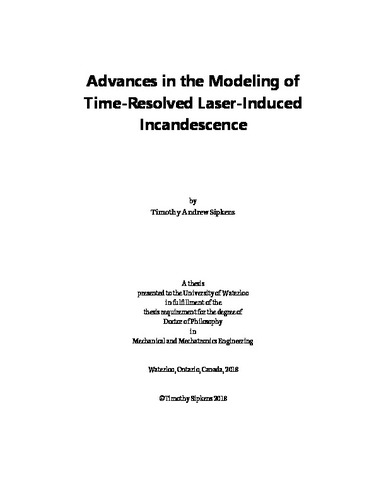| dc.description.abstract | Aerosolized nanoparticles represent both great potential for the development of emerging technologies and one of the biggest challenges currently facing our planet. In the former case, aerosol-based synthesis techniques represent one of the most cost-effective approaches to generating engineered nanoparticles having applications that range from medicine to energy. In the latter case, aerosolized soot is the second largest forcing factor after carbon dioxide in climate change models and contributes significantly to asthma, bronchitis, and various other respiratory illnesses. The increased predominance of engineered nanoparticles also presents significant environmental and health risks due to various toxicological effects. In any of these cases, robust characterization is critical to the function and regulation of these nanoaerosols.
Time-resolved laser-induced incandescence (TiRe-LII) is well-suited to meeting this challenge. Since its inception in the 1980s, TiRe-LII has matured into a standard diagnostic for characterizing soot in combustion applications and, increasingly, engineered nanoparticles synthesized as an aerosol. The in situ nature of the technique makes it well-suited to probe in-flame soot formation and the fundamentals of nanoparticle formation. Moreover, its cost-effectiveness and real-time capabilities make TiRe-LII particularly well-suited as an avenue for online control of nanoparticle synthesis.
TiRe-LII involves heating nanoparticles within a sample volume of aerosol to incandescent temperatures using a short laser-pulse. Following the laser pulse, the nanoparticles return to the ambient gas temperature via conductive and evaporative cooling. The magnitude of the peak spectral incandescence signal can be used to derive the particle volume fraction, while the temperature decay of the nanoparticles can be used to infer thermophysical properties, including the nanoparticle size, thermal accommodation coefficient (TAC), and latent heat of vaporization. Data analysis requires the use of spectroscopic models, used to convert the observed incandescence to a volume fraction or nanoparticle temperature, and heat transfer models, used to model the changes in the nanoparticle temperature over the duration of a signal. These models have evolved considerably over the past two decades, increasing the interpretive power of TiRe-LII.
Nevertheless, there are several factors that impede further improvements to the reliability of TiRe-LII derived quantities. Several anomalies have been observed in measured signals collected from both engineered nanoparticle and soot, ranging from faster-than-expected temperature decays to inconsistencies in measurements between laboratories and experimental conditions. Resolving these differences is crucial to improving the robustness of TiRe-LII both as a combustion and engineered nanoparticle diagnostic. However, this first requires the development of advanced analysis tools that allow for a better understanding of nanoscale physics and the uncertainties associated with model development.
This thesis presents several advances in the modeling and interpretation of TiRe-LII signals. The current state-of-the-art in TiRe-LII models is first established and the process of model inversion is discussed, with particular reference to uncertainty quantification within the Bayesian perspective. This lays the foundation for analysis of the measurement errors associated with TiRe-LII signals, providing practitioners with another source of information to characterize measurement devices and fluctuations in observed processes. Next, a novel approach to describe the relationship between the peak nanoparticle temperature and the laser fluence is derived. This allows the first comparison of fluence curves obtained using different instrumentation and under different measurement conditions. This dissertation proceeds by examining inversion of the spectroscopic model to determine both the nanoparticle temperature decay and the factor that scales emission from the nanoparticles to the observed signal. Unexpected temporal effects in the latter quantity are examined as an additional source of information that TiRe-LII practitioners can use for nanoparticle characterization and for diagnosing problems with measurement devices. Molecular dynamics simulations are employed to calculate the thermal accommodation coefficient, a parameter fundamental to the heat transfer model used in interpreting the inferred nanoparticle temperature decay, using the results are used in an analysis of TiRe-LII collected from iron, silver, and molybdenum nanoparticles. The cross-comparison of these materials highlights the utility of the developed analysis tools and provides fundamental insights into both nanoscale physics and bulk thermophysical properties. This dissertation concludes with a critical discussion of model development, emphasizing the importance of complexity and uncertainty in model selection. This is particularly important in the context of the context of the increasingly divergent set of TiRe-LII models available in the literature, indicative of model tuning. In summary, this dissertation not only presents direct improvements to the spectroscopic and heat transfer models used in traditional TiRe-LII analysis but also presents a set of new approaches by which the remaining challenges in TiRe-LII analysis can be resolved. | en |

